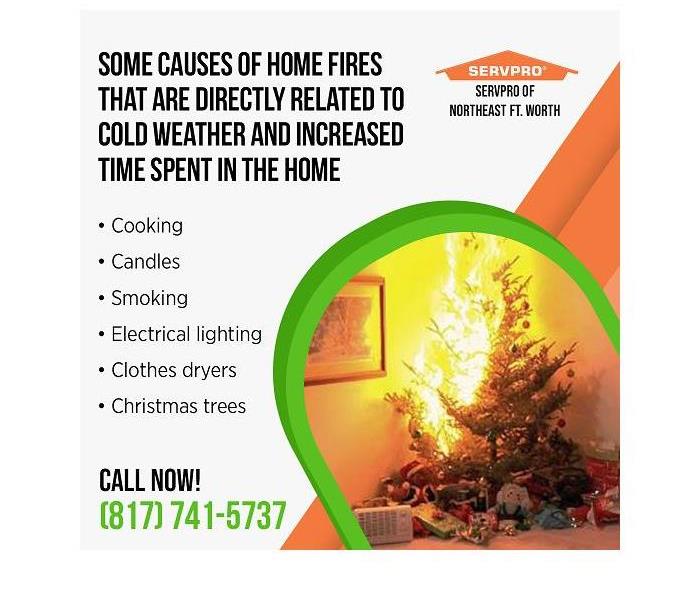Six Seasonal Fire Risks That Are Common in Winter
12/7/2021 (Permalink)
Blog Summary: Homeowners need to be aware of the fire hazards that threaten their homes during colder months. If fire damage should occur, local property owners can turn to the team at SERVPRO of Northeast Ft. Worth for fire damage restoration services.
Locally owned and operated, SERVPRO of Northeast Ft. Worth provides fire damage restoration services for the local area and serves the community with honesty and professionalism. SERVPRO technicians are highly trained in accordance with the highest IICRC standards. Customers can trust the property damage restoration team to handle any property damage disaster, including a fire damage disaster.
According to the National Fire Protection Association (NFPA), an estimated 360,000 home structure fires occur each year. The cost of these fire disasters approaches $6-8 billion in damages. Fire dangers are elevated during the winter months because the cold weather drives people indoors where life is warm, comfortable, and cozy.
Here are some causes of home fires that are directly related to cold weather and increased time spent in the home.
- Cooking
The primary cause of housefires and related injuries is cooking. An activity that involves hot burners or actual flames from natural gas or propane inside the home is a fire hazard by design. During the warmer months, outdoor grilling is very popular, especially in light of the recent pandemic. However, during the winter months, the cold drives this outdoor culinary activity indoors. Keep the home safe with the following fire prevention tips:
- While food is cooking, someone should remain in the kitchen to keep an eye on the food.
- Keep flammable materials such as potholders, paper products, towels, and dishcloths away from the stove even when the appliance is turned off.
- A clean stove free of grease buildup is a safer appliance.
- Keep children and pets a safe distance from the stove during food preparation.
- Candles
During the winter months and the holiday season, scented candles add a delightful aroma to the home environment while enhancing the decor. However, from 2012 to 2016, candles were responsible for an estimated 8,200 home fires, December being the peak month for this type of fire.
According to a source in the insurance industry, “Falling asleep was a factor in 11% of the home candle fires. Be sure to extinguish all candles before heading to bed at night, and never leave the room with any candles burning. Three of every five home candle fires occurred when some form of combustible material was left or came too close to the candle. Candles should be placed at a minimum of three feet from combustible materials such as your Christmas tree and/or decorations, curtains, blankets, etc.”
Safer, flameless decor options include plug-in air fresheners, oil diffusers, and wax warmers.
- Smoking
The leading cause of fire deaths in the United States is smoking-related materials, such as cigarettes, pipes, and cigars. In 2014, an estimated 17,200 house fires were caused by smoking.
Smoking safety tips:
- Avoid smoking indoors, especially during the cold winter months.
- Keep lighters, matches, and cigarettes away from children. A locked cabinet is the safest storage option for these items.
- Discard smoking materials with the utmost caution. Ensure that the butts and ashes have been doused and are completely extinguished.
- Electrical lighting
Almost half of all Christmas tree fires (43%) were related to electrical distribution, such as overloaded circuits or extension cord mishaps.
Christmas tree lighting tips:
- Discard strings of lights that have frayed wires or loose bulb connections.
- Follow the manufacturer’s recommendations for the number of light strands that can be connected.
- Do not decorate a live or artificial Christmas tree with lit candles.
- Before going to bed or leaving the house, turn off all Christmas tree lights.
- Convert to LED lights which are more energy-efficient and create much less heat.
- Clothes dryers
Homeowners report an estimated 3,000 dryer fires each year, and dryer fires cause around $35 million in property damage. Fall and winter are the peak months for dryer fires. Lint buildup is the major cause of dryer fires. Every time the dryer is used, clean the lint filters. Regularly inspect and clean the appliance. Homeowners who are unable to perform these safety tips can secure the services of reputable home services professionals who specialize in dryer inspection and maintenance.
- Christmas trees
Surprisingly, both live and artificial Christmas trees pose a fire risk in the home. A live tree is more likely to catch fire when it becomes dried out. However, artificial trees produce more severe flames that give off toxic chemicals and smoke. Great care should be exercised when using either type of tree.
Consider the following fire safety tips when using a live Christmas tree:
- Select a tree with fresh, green needles, which do not fall off when touched or jostled.
- Remove two inches from the trunk before anchoring the tree on the stand.
- Daily water the tree to keep the needles fresh and green.
- Christmas trees should be kept at least three feet away from a fireplace, heat vent, radiator, or other heat sources.
- Position the tree so that no doorways or hallways are blocked.
By pre-qualifying a fire damage restoration company, the homeowner is better prepared to meet the challenges of fire damage. In the event of a fire damage disaster, only one call will be needed to have a team of highly trained and experienced professionals arrive within an hour to begin the cleanup and restoration process.
For more information about Haltom City, TX, fire damage restoration, contact SERVPRO of Northeast Fort Worth, TX, by calling (817) 741-5737 or by emailing office@SERVPROnortheastftworth.com





 24/7 Emergency Service
24/7 Emergency Service
